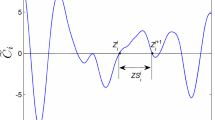Abstract
In this paper, we address the problem of blind extraction and separation of a continuous chaotic signal from a linear mixture consisting of some chaotic signal and/or random signals. The problem of blind extraction is firstly formulated as a problem of the synchronization-based parameter estimation. Then an efficient least square based parameter estimation method is introduced to determine the desired extracting vector. The proposed blind signal extraction scheme is applicable to blind separation of chaotic signals by formulating the separation problem as the extraction of each chaotic source. Numerical simulation shows that the proposed approach can blindly extract and separate the desired chaotic signals and it is also robust to measurement noise.
Similar content being viewed by others
References
K. J. Pope and R. E. Bogner. Blind signal separation I, linear, instantaneous combinations. Digital Signal Processing, (1996)6, 5–16.
K. J. Pope and R. E. Bogner. Blind signal separation II, linear, convolutive combinations. Digital Signal Processing, (1996)6, 17–28.
W. Hu and Z. Liu. Partially blind separation of continuous chaotic signals from a linear mixture. IET Signal Processing, 2(2008)4, 423–429.
Paolo, B. Arturo, F. Luigi, and F. Mattia. Separation and synchronization of piecewise linear chaotic systems. Physical Review E, 74(2006)2, 026212-1–026212-11.
Y. V. Andreyev, A. S. Dmitriev, E. V. Efremova, and A. N. Anagnostopoulos. Separation of chaotic signal sum into components in the presence of noise. IEEE Transactions on Circuits and Systems, I: Fundamental Theory Applications, 50(2003)5, 613–618.
T. Lo, H. Leung, and J. Litva. Separation of a mixture of chaotic signals. Proceedings of IEEE International Conference on Acoustics, Speech, and Signal Processing, Atlanta, GA, USA, May 1996, 1798–1801.
M. Cifici and D. B. Williams. An optimal estimation algorithm for multiuser chaotic communications systems. IEEE International Symposium on Circuits and Systems, Scottsdale, Arizona, USA, May 2002, Vol. 1, 397–400.
L. S. Tsimring and M. M. Sushchik. Multiplexing chaotic signals using synchronization. Physics Letters A, 213(1996)3, 155–166.
Y. Wang and W. X. Zheng. Blind extraction of chaotic signal from an instantaneous linear mixture. Circuits and Systems II: Express Brief, 53(2006)2, 143–147.
Z. Liu, X. H. Zhu, W. Hu, and F. Jiang. Principles of chaotic signal radar. International Journal of Bifurcation and Chaos, 17(2007)5, 1735–1739.
J. H. Peng, E. J. Ding, M. Ding, and E. Yang. Synchronizing hyperchaos with a scalar transmitted signal. Physical Review Letters, 76(1996)6, 904–907.
R. Konnur. Synchronization-based approach for estimating all model parameters of chaotic systems. Physical Review E, 67(2003)2,027204-1–027204-4.
D. Huang. Adaptive-feedback control algorithm. Physical Review E, 73(2006)6, 66204-1–066204-8.
Y. Zhang, C. Tao, and Jack J. Jiang. Parameter estimation of an asymmetric vocal-fold system from glottal area time series using chaos synchronization. Chaos, 16(2006)2, 023118-1–023118-8.
C. Tao, Y. Zhang, and G. Du. Estimating model parameters by chaos synchronization. Physical Review E, 69(2004)3,036204-1–036204-5.
U. Parlitz and L. Junge. Synchronization-based parameter estimation from time series. Physical Review E, 54(1996)6, 6253–6259.
J. L Breeden and A. Huebler. Reconstructing equations of motion from experimental data with unobserved variables. Physical Review A, 42(1990)10, 5817–5826.
J. Hu, S. Chen, and L. Chen. Adaptive control for anti-synchronization of Chua’s chaotic system. Physics Letters A, 339(2005)6, 455–460.
S. Chen and B. L. Luk. Adaptive simulated annealing for optimization in signal processing applications. Signal Processing, 79(1999)1, 117–128.
Author information
Authors and Affiliations
Corresponding author
Additional information
Supported by the National Natural Science Foundation of China (No.60472059) and the Aeronautical Science Foundation of China (2008ZC 52026).
Communication author: Liu Zhong, born in 1963, male, Ph.D., Professor.
About this article
Cite this article
Hu, W., Liu, Z., Li, C. et al. Partially blind extraction of continuous chaotic signals from a linear mixture. J. Electron.(China) 26, 600–607 (2009). https://doi.org/10.1007/s11767-007-0212-z
Received:
Revised:
Published:
Issue Date:
DOI: https://doi.org/10.1007/s11767-007-0212-z




